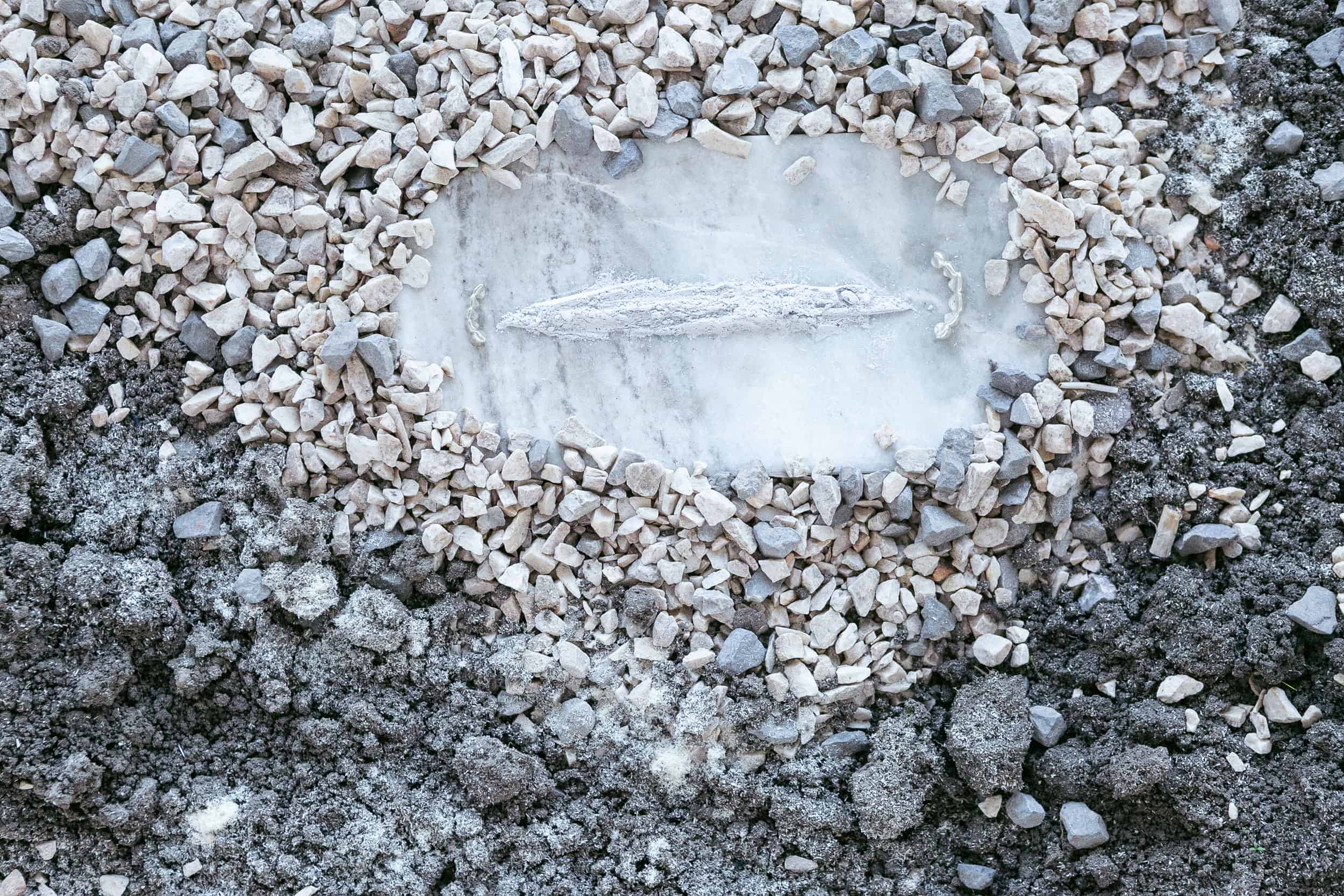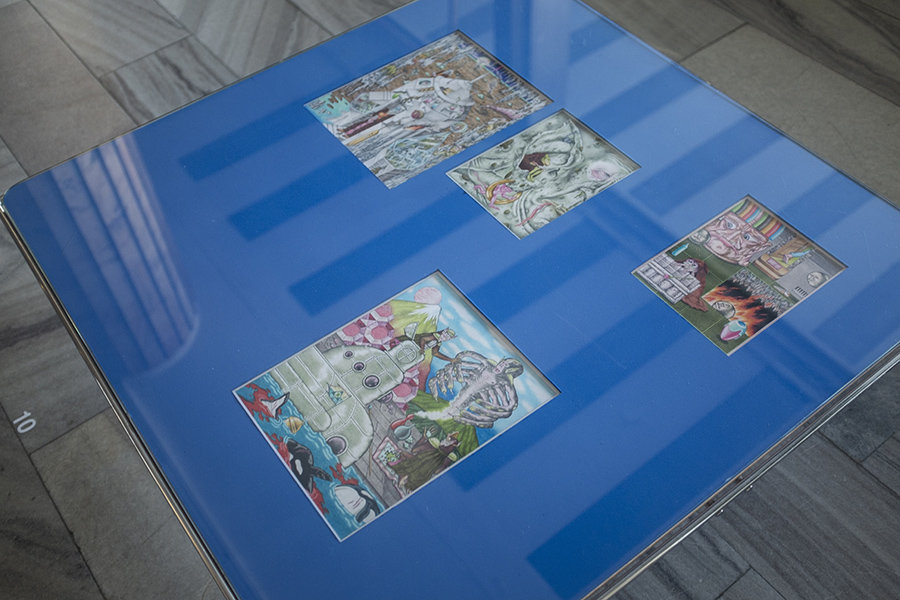An exhibition “The Vistula is Burning” was held last year at the Cracovia Hotel (21 October – 3 November 2020). Works of art referring to the climate crisis were presented in the historic interiors of the hotel owned by the National Museum. Magdalena Lazar and Katarzyna Skrobiszewska, the curators of the exhibition, are also the artists whose pieces were included in the show. They agreed to answer a few questions about the show’s subjects.
Małgorzata Marszałł: The title of an exhibit evokes the image of burning water, which seems astounding. Its subject refers to the environmental crisis. Is burning water a metaphor or your vision for the future?
Katarzyna Skrobiszewska: The title of our exhibit was inspired indirectly by the image brought by Michalina Bigaj: Andri Snaer Magnason shows us the Dettifoss waterfall filled with oil in flames. It’s the metaphor describing not so much the future as the present – litres of oil extracted daily from the earth are equal to the water flowing through the waterfall also on a daily basis. The title is meant to blast the alarm. In addition, burning water, which positions itself at the intersection of natural elements, signifies rebirth, a new beginning after the world as we know it came to an end.
Magdalena Lazar: The title aimed to trigger associations with our vicinity – this beautiful tragedy strikes right here next to us, not in some faraway lands. Burning water represents the clash of two elements. In the language of science, combustion involves oxidation, which generates heat and light. Water burns due to the temperature of its environment, which only keeps increasing. They say you can actually see the emitted light due to active oxygen and organic compounds by using very sensitive devices. It’s a gradual process. Otherwise, all water reserves on earth would go up in flames. Considering a disregard for the Vistula river, it might get polluted to such an extent that it will burst in flames just like the Cuyahoga River in America. Our territories might run dry as dust, too. The level of pollution in the Cuyahoga River was so staggering that the flames erupted at least thirteen times over. A number of artworks featured in this exhibit are based on scrutiny of natural phenomena. ‘Vistula is burning’ is also part of the lyrics of a song “Narodziny Zbigniewa” (“Zbigniew’s Birthday”) by Kora Jackowska.
M.M.: The climate crisis is an extremely relevant topic. How do the artists participating in the exhibit see the future on Earth? Are they quite pessimistic or hopeful about our ability to counteract adverse changes?
M.L.: Artists often represent the same point of view on things as scientists do – we just use a different language of communication. Visuality and creating immersive contexts for viewers allows them to explore the same observations in a more empathetic and sensuous manner of response. In science, they’re just converted to numbers. Ten years ago, I stopped in my tracks in the hallway of UdK Berlin, where I was studying for one semester as part of an exchange programme. I was completely hypnotized by Johannes Vogl’s video called “Swing” portraying a tire swinging in flames. This simple and powerful image seemed like the perfect metaphor of the utmost insolence with which we tend to approach nature. In his work, Johannes shows his acute perception of reality as well as a trickster’s bravado. His rain installation displayed in the Cracovia Hotel is absolutely in tune with our conversations about the former and current weather or our exhibition space. Whereas Michalina Bigaj often tackles the subject of artificial contact with nature, highlighting mankind’s illusion of control over the forces of nature. Her piece titled “Horyzont” (“Horizon”) is a distinctive symbol with a multiplicity of references. From a human perspective, it resembles the horizon over the setting sun. Yet, if we look at it from above, it might as well be a burning river. The only hope lies in the letters dispatched to the outer space. That’s the strategy adopted by Zuza Banasińska in her video “I didn’t go to Crimea and all I got was this alien message.” The differences between young people from the past and future seem to disappear in the messages sent to space which expand the notion of a family home to include the whole country or even the planet.
Hungry for more?K.S.: The eyes of the children portrayed in the paintings by Lea Gudrich are filled with silent blame. They are the ones who will bear the brunt of the impending catastrophe. Even today, the aftermath of extreme weather conditions, droughts, fires, conflicts, and migrations is the most severe in the Global South – the place of origin of children depicted in the painting. Lea invokes the metaphor of an ark as our only mean of survival. To survive, we need to build the true ark, a home, make space for values, collective consciousness, law and solidarity transcending only what’s human.
If hope doesn’t resonate particularly strongly through our exhibit, then perhaps it is the high time we engaged in some work of mourning. Psychologists agree that it is a natural and necessary response in the face of the sudden and quickly progressing climate change. In this context, “Bez tytułu” (“Tydzień deszczu”) [“Untitled” (“Week of Rain”)] by Johannes Vogl could be interpreted as the tears shed over something that we are losing right now and our ultimate acceptance of today’s broken world. Through her video installation, Tijana Petrović invites us to fundamentally reevaluate our relationship with the world by meditating on the rain and light pouring over the horizon as the Sun rises and sets. “Krajobraz zmienny” (“VariableLandscape”) by Emilija Radojičić and Mario Kolarić poses a series of questions about our position, our goals and pursuits. Reflection on who we are as people and redefinition of ourselves are incredibly important in the context of the climate crisis. Is human nature inherently evil, or are we better than we think? Perhaps Rutger Bregman is correct that a negative image can have a nocebo effect and become a self-fulfilling prophecy.
We can recently observe an avid interest in the topic of flora among artists and curators. Does this “green revolution” result from the upcoming climate disaster, or does it originate from other processes? Together with Aneta Rostkowska, a curator, we are talking about her most recent exhibition at Temporary Gallery in Cologne devoted to these areas of contemporary art.
M.M.: The exhibit took place in the historic Cracovia Hotel from the 1960s that hosts other works of art: the mosaic by Krystyna Zgud-Strachocka and “Miasta” (“Cities”) by Helena and Roman Husarski. Does the show enter into a dialogue with this space, utilize or reference it in some way?
M.L.: The show was created very organically and was linked closely to the surrounding space. The dormant hotel was an immensely inspiring testament to the bygone era. The Split Sun burning twice as strongly, meaning the beautiful mosaic by Krystyna Zgud-Strachowska, is an excellent counterpoint to the “The Sun is lighter on the horizon”, a piece by Tijana Petrović. Marble embellishments in the hall corresponded with the futurist visions depicted in the drawing of Davor Gromilović. Work under the title “Zimny, zimny marmur” (“Cold, Cold Marble Stone”) transported us to the time when the citizens of the Blue Planet were frolicking around empty rooms, cooling their hands on cold marble, and burning in the closed boiler room. Whereas Kasia Skrobiszewska was inspired by the suspended ceiling characteristic of interiors with a practical function. Her artwork alludes to the culture of fake news, disinformation, and the belief that climate change is a hoax. Will only the ceiling falling down on our heads finally open our eyes?
K.S.: The point of departure for my work was the suspended ceiling in the Cracovia Hotel that seems as if it is about to crumble in some places. Bodies exposing previously concealed dimensions fall out of the structure which goal is to soundproof and warm up the interiors. Their eerie forms illustrate our difficulty with grasping the phenomena related to the climate crisis. We tend to repress our awareness of their existence in a more or less conscious manner. Invited artists have also created a kind of site-specific installation from the fabric covering the mosaic “Miasta” (“Cities”) by the Husarskis located in the former office of Orbis travel agency. The mosaic depicts potential travel destinations for those trapped behind the Iron Curtain. What is more, the piece “Krajobraz zmienny” (“Variable Landscape”) by Emilija Radojičić and Mario Kolarić represents our attempts at finding ourselves amidst a disorienting reality. “Are we looking for something that has already found us?” the artists from Serbia asked. The current situation made us realise that humanity is capable of taking serious steps towards combating the effects of this pandemic. But could we allow ourselves to be cautiously yet decidedly optimistic when it comes to the climate?
M.M.: The exhibit is a part of the project called “Nature is My Homeland”. Could you please tell our readers what this project is about?
K.S.: The project of the Academy of Fine Arts in Krakow focused on the notion of the ancient homeland, in other words nature, in relation to the cultural anthropology, art history, and natural sciences. Students and teachers from four universities alongside invited artists, scientists, and experts from Poland, Serbia, Germany, and the US. Together they analysed the models of human contact with nature and their reflection in art. The project involved a series of workshops, exhibitions, interviews with artists and scientists. Four universities participated in the project: us – Jan Matejko Academy of Fine Arts in Kraków, The University of Applied Sciences in Trier, The Faculty of Fine Arts at the University of Arts in Belgrade, and The College of Arts and Sciences at the University of Alabama.
Financed by the National Agency for Academic Exchange (NAWA)
Organiser: the Jan Matejko Academy of Fine Arts in Kraków
Project Partners:
- HS University of Applied Sciences & Design Trier, Germany
- University of Alabama College of Arts and Sciences, New College, USA
- Faculty of Fine Arts of the University of Arts in Belgrade, Serbia
Magdalena Lazar, (…), installation, 2020, photo by Natalia Szułdrzyńska
Davor Gromilovic, coloured pencil and graphite on paper, photo Magdalena Lazar


















